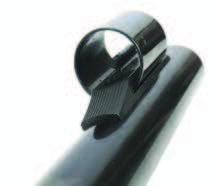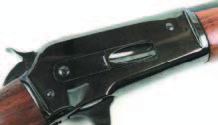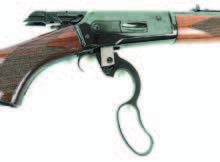Gun Tests Grade: A-
$1836
The Taylor’s & Company 1886/71 Classic Rifle is a replica of the Winchester Model 71 built from 1935 through 1958. The Model 71 was a modified Model 1886 designed for easier and more efficient manufacture. It was also chambered in one caliber, 348 Winchester, though there are a few rare models chambered in 45-70 and 33 WCF. The Model 71 had a following in Alaska and Canada where the heavy, powerful caliber offered good medicine on bear and moose. The bolt on the Taylor’s uses two steel locking lugs to ensure the bolt stays closed during firing.
| Action Type | Lever-action, exposed hammer |
| Overall Length | 37.5 in. |
| Barrel | 24 in. long; 1:20 RH twist, blued steel |
| Overall Height | 8.12 in. |
| Weight Unloaded | 7.8 lbs. |
| Weight Loaded | 8.5 lbs. |
| Sight Radius | 19.87 in. |
| Receiver | Alloy steel |
| Action | Blued steel |
| Barrel | Blued steel |
| Magazine Capacity | 4 |
| Magazine Type | Tube |
| Stock | Checkered walnut; sling swivel studs |
| Stock Drop at Comb | 2.25 in. |
| Stock Drop at Heel | 3.0 in. |
| Stock Bedding | None |
| Stock Buttplate | Solid rubber recoil pad |
| Stock Length of Pull | 14.5 in. |
| Front Sight | Blade w/brass bead |
| Rear Sight | Adj. semi-buckhorn rear; drilled and tapped |
| Trigger Pull Weight | 6.2 lbs., single-stage |
| Manual Safety | None |
| Warranty | 1 year |
| Telephone | (540) 722-2017 |
| Website | TaylorsFirearms.com |
| Made In | Italy (Chiappa) |

Out of the box, it was hard not to fall into lust over the traditional deep blued-metal finish and nicely grained walnut wood. The pistol grip area and forearm were nicely checkered. The forend was tapered at the ends where that fit into the metal and slightly thicker in the center. The solid rubber buttpad had rounded edges so it would not get hung up on clothing when quickly shouldering the rifle. A blued-metal pistol-grip cap is also installed. Like the original Model 71, this replica is equipped with a half magazine and blued end cap on the forend. The barrel is slightly tapered and sports a brass-bead post front sight with a removable hood. In areas where you hunt in snow, it’s guaranteed the hood will collect snow and obscure the front post. Best to remove the hood when it is snowing. The rear sight is a semi-buckhorn with a stepped ladder to adjust elevation. To adjust windage, you need to use a nylon or brass hammer to tap left or right. The sights were dead on at 50 yards.

What we liked about the Taylor’s was the left-side receiver was drilled and tapped for the Lyman 66WB peep sight ($103; Brownells). You can find many original Winchester 71s have this style of sight installed and the factory rear sight removed. The bolt is also machined to accept a Bolt Rear Sight ($105; TaylorFirearms.com). This sight sits in the two slots cut in the top of the bolt and is secured with an additional screw. On the bottom right side are two screws that adjust windage and also lock the eyepiece position. This sight is manufactured by Pedersoli. Both the Lyman and Pedersoli sights offer micro adjustments and fast target acquisition. The barrel is also tapped to mount an optic, a la scout-rifle style.

There is no rebounding hammer-safety mechanism built into the Taylor’s hammer, so use the half-cock hammer safety so the hammer does not come into contact with the firing pin. The hammer was smooth and easy to cock, with a fine texture. We would have liked the serrations to be a bit toothier. We found this rifle was easy to load via the side-load gate. The cartridges are substantial, and it was easy and smooth to insert them and load them in the magazine tube.

The lever is curved to match the pistol-grip stock and was smooth to operate. Since the loop is on the small side, large-handed shooters wearing gloves may have an issue fitting all their fingers into the loop. Also, the loop’s convex shape worked against the fingers in your hand and was not as comfortable to operate. The Taylor’s has the shortest lever throw of all three rifles tested. It was fastest with a follow-up shot. Truth be told, in this chambering you won’t use the loop to blaze through shots as you would, say, in Cowboy Action Shooting. It had a smooth stroke and was a very easy rifle to shoot, with a long sight radius and good balance. At nearly 8 pounds, the weight also helped absorb recoil, and the rubber buttpad softened the blow. The forend felt thin in the hand.
The trigger had a bit of creep and broke at 6.2 pounds. We would have liked the trigger a bit lighter. Our best three-shot group came with the Winchester Super-X ammo and measured 1.23 inches. The 325-grain Hornady came in a close second with 1.93 inches. Our average groups across all ammos ranged from 2 to 3.5 inches. Not bad for open sights and definitely MOD (minute of deer). In our opinion, the Taylor’s offered less felt recoil. Don’t get us wrong — there was plenty recoil — but we felt it less with the Taylor’s.
Our Team Said: We’d hunt with this rifle in a heartbeat. The Taylor’s is a fine, traditionally-styled big-bore lever action with plenty of iron sight and optic mounting options. If you have always wanted to own a Winchester Model 71, this will scratch that itch without the high cost of an original.
45-70 Government Range Data
To collect accuracy data, we fired three-shot groups from a bench using a rest. Distance: 50 yards with open sights. We recorded velocities using a ProChrono digital chronograph set 15 feet from the muzzle.| Hornady Leverevolution 250-grain FTX | Taylor’s & Co.1886/71 Classic Rifle | Marlin 1895SBL | Henry All-Weather |
| Average Velocity | 1983 fps | 1825 fps | 1842 fps |
| Muzzle Energy | 2183 ft.-lbs. | 1849 ft.-lbs. | 1882 ft.-lbs. |
| Smallest Group | 3.47 in. | 1.79 in. | 2.55 in. |
| Average Group | 3.57 in. | 2.69 in. | 3.10 in. |
| Hornady Leverevolution 325-grain FTX | Taylor’s & Co. 1886/71 Classic Rifle | Marlin 1895SBL | Henry All-Weather |
| Average Velocity | 1957 fps | 1815 fps | 1786 fps |
| Muzzle Energy | 2764 ft.-lbs. | 2378 ft.-lbs. | 2302 ft.-lbs. |
| Smallest Group | 1.93 in. | 2.61 in. | 2.06 in. |
| Average Group | 2.82 in. | 3.09 in. | 2.83 in. |
| Winchester Super-X 300-grain JHP | Taylor’s & Co. 1886/71 Classic Rifle | Marlin 1895SBL | Henry All-Weather |
| Average Velocity | 1588 fps | 1589 fps | 1533 fps |
| Muzzle Energy | 1680 ft.-lbs. | 1682 ft.-lbs. | 1566 ft.-lbs. |
| Smallest Group | 1.23 in. | 1.71 in. | 2.96 in. |
| Average Group | 1.94 in. | 2.14 in. | 3.94 in. |


























